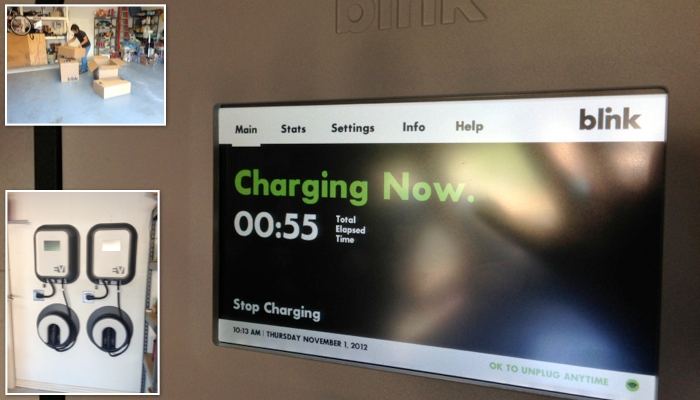 I’ve been waiting for this moment for almost as long as I’ve owned my Volt. Today, our two Level 2 chargers were installed! Instead of a full charge taking 10 hours, it should drop to 4 hours. Yes, Level 2 chargers are expensive, but we got both units for free. We had to pay for installation only. (more on that later in this post)
I’ve been waiting for this moment for almost as long as I’ve owned my Volt. Today, our two Level 2 chargers were installed! Instead of a full charge taking 10 hours, it should drop to 4 hours. Yes, Level 2 chargers are expensive, but we got both units for free. We had to pay for installation only. (more on that later in this post)
Why is the time it takes to charge important, if you charge while you sleep? Each of our daily commutes uses up almost the entire charge. Any additional driving we do after that requires usage of the ‘range extender,’ in other words, burning gasoline. The last time I ran checked the OnStar RemoteLink app, my overall MPGe was 140 miles per gallon equivalent. That’s factoring both my electric and gasoline usage. (I picked up my Volt on August 3rd, so on November 3rd, I’ll post an update of my stats on my blog.)
**UPDATE** I have determined that the MPG estimate generated by the app is not accurate, unless the cost of gasoline versus electricity is factored in. I have come up with a method I think is more accurate, using the relative costs of both energy types. A detailed explanation may be found here.
When running the range extender, I get approximately 37 MPG. That means, when I’m just using electricity, I am doing MUCH better than that. So far, I have been using gasoline for about 1/4 of the miles I have driven. When I get home from work and my battery’s depleted, even though I start charging immediately, I just don’t get enough ‘juice’ back into the battery quickly enough for my errands. By plugging in for just one hour with these new chargers, I could have 10-11 miles of electric range. Usually, that is sufficient for my errands. My current estimate of gasoline use is $393 per year, so if I can cut that in half, I can save almost $200 more per year. My actual goal is to almost eliminate gasoline usage entirely.
How did I get these chargers for free? In August of 2009, the U.S. Department of Energy awarded a grant of $99.8 million to fund these chargers for areas that have air pollution issues. Unfortunately (and I guess, fortunately) I live in an area with air quality issues (Dallas / Fort Worth), and qualify for the program. You can have one charger per EV. As you can see in the photo above, we now have two chargers, one for each of our two Volts.
Why would the government do this? Creeping socialism? Social engineering? To be warm and cuddly? No, as it turns out, they want to gather data about how the chargers will be used, their impact on the electrical grid and to help move Americans toward alternative fuels by deploying the needed charging infrastructure. In order to receive a free charger, you have to supply an Internet connection for the charger to phone home and report the data the government needs. This is said to be anonymous, but either way, I didn’t care. If I’m going to write about all this on my blog, what do I care if Uncle Sam wants a front row seat? For information on the program, called The EV Project, go here.
There are costs involved, even if the chargers are free. I had to run two 240 volt, 40 amp circuits to the garage to have a place in which to plug the chargers. Electricians quoted about $1,000 and $600 to do this. I’m somewhat handy, so with the help of a neighbor, I ran the lines myself. I had room for expansion in our electrical panel, so it was a relatively straight-forward process to do. I think we did a pretty good job too. My cost for the 40 amp GFCI breakers, #8 gauge, three conductor wire, and NEMA 6-50R outlets was about $450. The electrician’s quotes were for non-GFCI breakers, which would have reduced the overall cost about $220, so by doing the work myself, I saved at least $370 and got a safer setup than what the professionals would have installed. I admit, there is ground-fault protection built into the Blink chargers, but I was concerned about the wall outlets themselves, so I may have gone overboard. The national electric code requires GFCI outlets for all new outlets installed in a garage, so I thought it best to be safe.
On top of the circuit run, you have to pay for having the units installed by program-approved electricians. At the time I did this, the program had funds available to defray tha cost as well. There was a $400 installation voucher and an additional $250 ‘promotional’ discount for units, if ordered before the end of October. Wow! $650 for each installation should be enough to mount the units on the wall (8 screws) and plug them in, right? Well, no.
The quote I received for the first charger, which was going to include the run of the circuit, was $1,529 ($1,079 after discounts and incentives). That’s for one charger. It’s at this point I decided I needed to have the circuit run by an electrician I had used in the past or do that work myself. I let the program know I was going to have the circuit run with breaker and outlet and all their tech would have to do is hang it and plug it in.
The program re-quoted the project and the amount was reduced to $969 ($319 after discounts and incentives). Wow. I just could not believe that. I contacted the program, wanting to make sure they understood how little work remained and to see if the quote was correct. They didn’t budge on pricing. They explained that I would be getting a $1500 charger for $319. I swallowed my pride and accepted the quote. They also said, by having their approved electrician install the units, I would have a 3 year warranty, instead of the usual 1 year. (of course, you can’t have the charger unless you have their electricians install it…) At this point, I signed the required forms and apparently fell into a bureaucratic pit. Everything seemed to stop. I emailed asking if they received my paperwork, but nothing seemed to be happening.
After about 17 days, we decided to get my wife a Volt. There is an earlier blog entry explaining this. I contacted the program to let them know I’d need two chargers and sent them photos of the wall outlets, showing we were ready to go. They said they’d have to generate another quote and I’d have to submit a new request for the additional charger. It is, after all, the government…
Once again, I was floored, when the quote for the second charger’s installation arrived. This time, the quote was $1,036 ($386 after discounts and incentives). That was $67 higher than the quote for the first charger’s installation! They were identical installations!! They were to be located two inches away from one another? Once again, I called the program but could get no explanation for this discrepancy. With the end of October rapidly approaching, bringing with it the possibility of losing the two $250 ‘promotions,’ I caved and we submitted the paperwork for both chargers.
The installation was pretty straightforward and painless. Tying into my wireless network was a bit of a hassle because, when using DHCP, the router’s IP address was incorrect. I’m not a networking guru, but I knew enough to try giving the units hard coded IP addresses and to enter the correct router and DNS addresses. Once this was done, the chargers phoned home, got updates to their operating software, set their date and time and were ready to use.
I may have griped a lot about the installation fee confusion, but let me say this: I am grateful for this program and for having these two chargers in my home. They will help us use even less gasoline than we’ve been using, saving us tons of money and making the Volts even more affordable. This may seem like a handout to some of you, but it is my belief that one function of government is to help the nation move forward in areas critical to the environment, national security or other reasons. This is done all the time through tax incentives and deductions, such as the deduction for mortgage interest. The government thinks it’s a good idea for Americans to own their own homes, so they’ve provided a tax deduction to make home ownership a bit less expensive.
As usual, I will keep you posted on how these charges are working out.
One last thing: I just received an email from my charger, letting me know my car is fully charged. Is that cool or what?!?




Comments